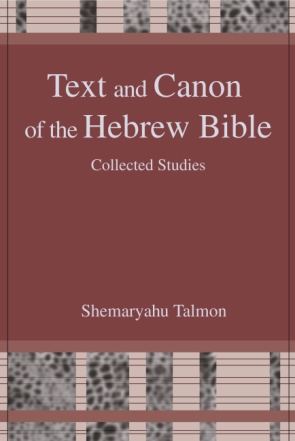Text and Canon of the Hebrew Bible
Collected Studies
Shemaryahu Talmon
The essays by Shemaryahu Talmon (1920-December 15, 2010) presented in this fourth volume of his collected studies in English were written against the background of the momentous manuscript finds at various sites in the Judean Desert, including approximately 200 biblical or Bible-related manuscripts and manuscript fragments discovered at Qumran. These discoveries date from the crucial period of the turn of the era and afford scholars unprecedented information on the early transmission history of the biblical text.
- Description
- Table of Contents
Talmon likens the transmission process (in agreement with Paul Kahle, and contrary to Paul de Lagarde) to a confluence of variant pristine traditions that Judaism, Christianity, and the Samaritan communities severally channeled into one fixed and closely circumscribed text form. It is his thesis that at least some of the “biblical” manuscripts and fragments from Qumran preserve original variants of the wording in the Masoretic Text, which eventually was recognized and transmitted in Judaism as the acclaimed and exclusively binding wording of the Hebrew Bible. These manuscripts and fragments evidence a “textual strategy” consisting of the interaction of the original authors and the transmitters of their work. Scribes and editors were minor partners of the authors. They did not refrain from occasionally changing wordings within a given range of “poetic license,” often adapting literary techniques and patterns that had been used by the primary creators of the texts that they copied.
The 18 essays reprinted in this volume relate to a variety of phenomena that affected the biblical literature in the stages of transition from oral tradition to hand-written transmission, initially in Paleo-Hebrew, then in the square alphabet, and ultimately in the promulgation of the Masoretic version in print.
Talmon’s articles published herein initially appeared over a period of about 50 years, thus giving expression to his developing thought regarding the transmission history of the biblical text up to the present time. The papers have undergone revision in the process of preparing the present volume. Scholars and students alike will benefit from owning and using this superb comprehensive collection of studies.</p>
Preface
Sigla
Introduction
The Textual Study of the Bible:
A New Outlook
Oral Tradition and Written Transmission, or the Heard and Seen Word in Judaism of the Second Temple Period
The Paleo-Hebrew Alphabet and Biblical Text Criticism
Synonymous Readings in the Masoretic Text
Double Readings in the Masoretic Text
1 Sam 15:32b:
A Case of Conflate Readings?
A Case of Abbreviation Resulting in Double Readings
Emendation of Biblical Texts on the Basis of Ugaritic Parallels
A Case of Faulty Harmonization
The Town Lists of the Tribe of Simeon
‘These Are the Kenites Who Came from Hammath
Father of the House of Rechab’ (1 Chr 2:55) [Hebrew]
Amen as an Introductory Oath Formula
An Apparently Redundant Reading in the Masoretic Text (Jer 1:18)
The Three Scrolls of the Law Found in the Temple Court
Prolegomenon to The Ten Nequdoth of the Torah
Pisqah Be’emsa’ Pasuq and the Psalms Scroll from Qumran Cave 11 (11QPsª)
Textual Criticism: The Ancient Versions
The Crystallization of the “Canon of Hebrew Scriptures” in the Light of Biblical Scrolls from Qumran
Bibliography
Abbreviations
Index of Sources
Index of Authors
Mailing List
Subscribe to our mailing list and be notified about new titles, journals and catalogs.




